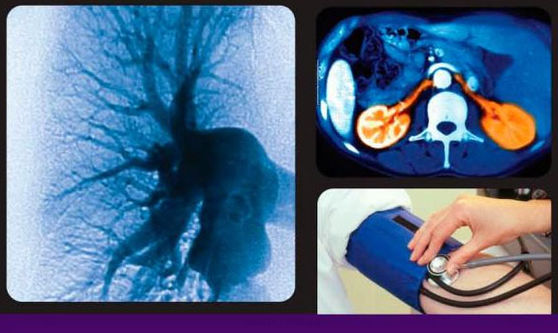
Prevention and Treatment of Cardiovascular Disease in Adolescents and Adults through the Transcendental Meditation® Program
A Research Review Update 2012 : Current Hypertension Reviews
Abstract: The pathogenesis and progression of cardiovascular diseases are thought to be exacerbated by stress. Basic research indicates that the Transcendental Meditation® technique produces acute and longitudinal reductions in sympathetic tone and stress reactivity. In adolescents at risk for hypertension, the technique has been found to reduce resting and ambulatory blood pressure, left ventricular mass, cardiovascular reactivity, and to improve school behaviour. Research on adults with mild or moderate essential hypertension has reported decreased blood pressure and reduced use of anti-hypertensive medication. The technique has also been reported to decrease symptoms of angina pectoris and carotid atherosclerosis, to reduce cardiovascular risk factors, including alcohol and tobacco use, to markedly reduce medical care utilization for cardiovascular diseases, and to significantly decrease cardiovascular and all-cause morbidity and mortality. These findings have important implications for inclusion of the Transcendental Meditation program in efforts to prevent and treat cardiovascular diseases and their clinical consequences.
These findings have important implications for inclusion of the Transcendental Meditation program in efforts to prevent and treat cardiovascular diseases and their clinical consequences.
CONCLUSION
In summary, the TM technique is an easily learned, cost-effective means of reducing resting and ambulatory BP and CV reactivity, and lowering LVM in adolescents at risk for hypertension. In adults with mild or moderate EH, TM practice decreases BP, reduces the use of anti-hypertensive medication, and decreases angina pectoris and carotid atherosclerosis. It markedly reduces medical care utilization for CVD, especially in older individuals, and it significantly decreases CVD and all-cause mortality. It decreases resting heart and respiratory rates and cortisol levels, improves CV function, and decreases stress-related risk factors, including alcohol and tobacco use. The mechanism of the effects of TM practice appears to be through acute and longitudinal reductions in sympathetic tone and reactivity to stress.
Considerable compelling evidence for the efficacy of TM practice as an approach to preventing and controlling EH and CVD risk has also been documented in extensive reviews [103, 138, 154, 201, 202]. Evidence presented offers a basis for public health policies and clinical approaches that can greatly affect the incidence and consequences of EH and CVD in the population at large [202]. The effective implementation of stress reduction depends to a large extent on the training and motivation of the health care administration. Large-scale clinical trials are needed to determine if this approach can reduce the incidence of EH and CVD when applied on a widespread basis. The medical, financial, and humanitarian significance of such research can hardly be overestimated. The support and involvement of health professionals, educators, community organizations, industry, and government together is necessary to support the adoption of healthy lifestyles for our society for succeeding generations [133]. Intervention through stress reduction in youth and adults is suggested as a future direction for preventive cardiology [202].
To our knowledge, the trials on the TM technique described here are the first RCTs to demonstrate improvement in CVD risk factors, CV clinical events, and mortality rates through a meditation program. If such improvements are replicated among other at-risk groups and in cohorts of CVD patients, this will have important implications for inclusion of this technique in the efforts to prevent and treat CVD and its clinical consequences.
Références :
[103] Walton KG, Schneider RH, Nidich SI, et al. Psychosocial stress and cardiovascular disease Part 2: Effectiveness of the Transcendental Meditation program in treatment and prevention. Behav Med 2002; 28:106-123.
[133] Lawrence M, Arbeit M, Johnson CC, et al. Prevention of adult heart disease beginning in childhood: intervention programs. Cardiovasc Clin 1991; 21: 249-262.
[138] Schneider RH, Alexander CN, Salerno J, et al. Stress reduction in the prevention and treatment of cardiovascular disease in African Americans: a review of controlled research on the Transcendental Meditation (TM) program. J Soc Behav Pers 2005; 17: 159-180.
[154] Orme-Johnson DW, Barnes VA, Schneider RH. Transcendental Meditation for Primary and Secondary Prevention of Coronary Heart Disease. In: Heart & Mind: the Practice of Cardiac Psychology. Edited by Allan R, Fisher J, Second edn. Washington, DC: American Psychological Association 2011: 365-379.
[201] Schneider RH, Alexander CN, Wallace RK. In search of an optimal behavioral treatment for hypertension: A review and focus on Transcendental Meditation. In: Personality, Elevated Blood, and Essential Hypertension. Edited by Johnson EH, Gentry WD, Julius S. Washington: Hemisphere Publishing Corporation; 1992 : 291-318.
[202] Walton KG, Schneider RH, Salerno JW, et al. Psychosocial stress and cardiovascular disease Part 3: Clinical and policy implications of research on the Transcendental Meditation program. Behav Med 2005; 30:173-183.
ISSN: 1573-4021 (Print) ISSN: 1875-6506 (Online) Volume 8, 4 Issues, 2012


